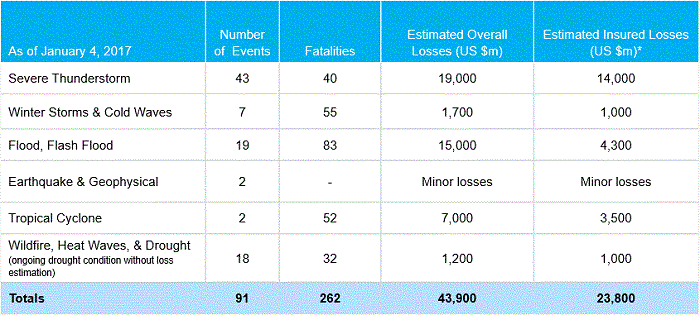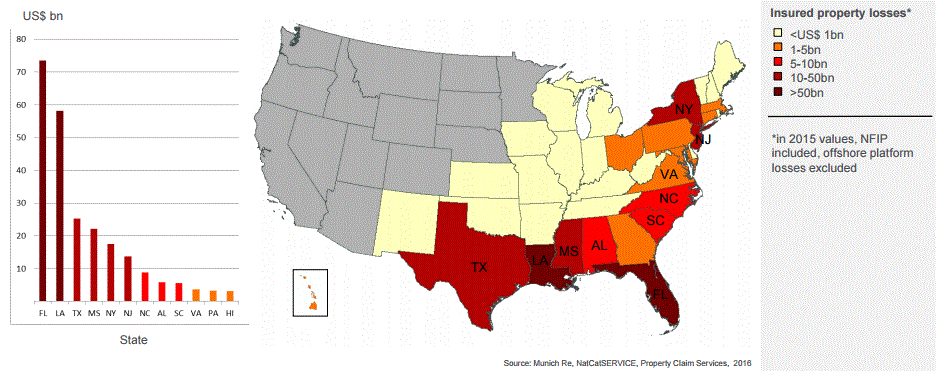Florida has some of the highest insurance rates in the country, and for good reason. Of the ten most damaging hurricanes in the United States, seven hit in 2004 and six occurred 2005 in Florida. The state is still dealing with the aftermath of 2017’s Hurricane Harvey and Irma.
But, hurricanes aren’t the only natural disasters to affect Florida. The Sunshine State isn’t always sunny, and living in Florida means being ready to take on dangerous weather. In 2016 Florida ranked 6th in the nation for wildfires and 7th for tornadoes.
If you want to live in Paradise and own a home in Florida, you need to be prepared to pay high premiums. The NAIC reports that Florida homeowners with a H03 policy pay an average of $1,993 per year, compared to the national average of $1,173.
You also need to get to know some insurance companies you might not have heard of many of the big insurance providers avoid Florida like the plague. Now State Farm as an example willfully accepts Auto but won’t touch you with Homeowners coverage. The landscaping is changing and will continue to change.
The Sunshine State isn’t always sunny, and living in Florida means being prepared to take on dangerous weather. In 2016 Florida ranked 6th in the nation for wildfires* and 7th for tornadoes.
If you want to live in Paradise then ….
If you want to live in Paradise and own a home in Florida, you need to be prepared to pay high premiums. The NAIC reports that Florida homeowners with a H03 policy pay an average of $1,993 per year, compared to the national average of $1,173.
You also need to get to know some insurance companies you might not have heard of, many of the big insurance providers avoid Florida. Now State Farm as an example willfully accepts Auto but won’t touch you with Homeowners coverage. The landscaping is changing.
Flood insurance is a must in most Florida counties — but it won’t be included in a standard home owners insurance policy. If your insurer doesn’t offer a separate flood insurance policy, you can buy flood insurance through the NFIP.
Storm surge is one of the primary causes of hurricane-related property damage along the Gulf of Mexico and Atlantic coastlines. It combines a total of approximately 3,700 miles of coastline, extending from Maine to Texas
No coastal areas are completely free every state along the coast has some degree of storm surge susceptibility.
Comparing residential exposure by coastal region shows that a total of more than 3 million homes are at risk along the Gulf Coast from Texas through the tip of South Florida. Another 3.9 million homes make up the remaining Atlantic Coast, from South Florida to the tip of Maine. *CoreLogic
There is substantial variation in storm surge risk by state. Factors such as the length of a state’s coastline, nearshore land elevation and the density of residential development all combine to determine an area’s susceptibility to flooding from storm surge.
Texas and Florida have a greater number of homes at risk than other states, primarily due to the length of their individual coastlines. As in previous years, Florida had the most exposure to storm surge flooding, with more than 2.7 million homes vulnerable
While New York is not as frequently affected by hurricanes and storm surge, the density of the residential population near the coast makes it extremely vulnerable to flooding. Due to the concentration of its residences, New York ranks fifth in the number of homes at risk.
Florida is one of nineteen states (plus the District of Columbia) that require homeowners to have hurricane deductibles in addition to their standard insurance deductible. Hurricane deductibles are calculated as a percentage of your total home value.
This means that if a hurricane damages your home, you’re responsible for paying the cost of the deductible — which can be up to 10% of your home value, depending on your policy — before you receive any payment from your insurance company.
Florida has high insurance rates to begin with, and they’re only getting higher — especially because Florida contractors are filing more and more assignment of benefits claims. Here’s how an AOB claim works: A contractor offers to fix a common household problem, such as a burst water pipe, while also asking homeowners to sign over their insurance benefits. In some case’s the homeowners are unaware that they are signing over their benefits. Always read your contracts, and avoid signing anything mentioning “assignment of benefits” or “AOB”. After the homeowner’s sign, the contractors can go after the claims themselves, and sue the insurance companies if the claims are denied.
The Tampa Bay Times reports that AOB claims have gone up by nearly 7000% in the past decade — and the more insurance companies have to deal with AOB claims and lawsuits, the more they have to raise their rates to compensate.
If a contractor independently approaches you about damage to your home, they might be trying to get an AOB claim out of you — so tell them you’re not interested. You can always hire your own contractor if you need one.
We at Home & Away Residential Services work with anyone and everyone. Everyone should have a Personal Property Inventory (PPI).
In 2017 there were a total of 17 named storms occurred in 2017. Ten of these storms were hurricanes, and six of those hurricanes were identified as “major” hurricanes achieving Category 3 status or higher.
Damage from the hurricanes was caused by wind, precipitation-based flooding and storm surge flooding. The back-to-back storms of Hurricane Harvey and Hurricane Irma were the most devastating to the U.S. mainland.
The 2017 Atlantic Hurricane Season ended the 12-year-long major hurricane drought in the U.S. Hurricane Harvey was the first major hurricane to make landfall in the U.S. since Hurricane Wilma in 2005. Harvey was a Category 4 hurricane before making landfall near Rockport, Texas. The storm then stalled over Texas for several days, causing unprecedented amounts of rainfall and catastrophic flooding across the Houston metro area.
Hurricane Irma – a Cape Verde hurricane – made four landfalls in the Caribbean along its path before making its first landfall in the U.S. as a Cat 4 hurricane in the Florida Keys, and then continuing to make a second landfall as a Category 3 in southwestern Florida.
Hurricane Irma overall flood damage of both residential and commercial properties was estimated to be between $29 billion and $46 billion. Approximately 50 percent of the storm surge damage from Hurricane Irma came from the counties in Florida.
- Saint-Johns
- Miami-Dade
- Broward
- Brevard
- Collier
Sixty-nine hurricanes have made landfall in Florida, including Hurricane Irma, since 1900. Of these, about 29 hurricanes were major hurricanes (Category 3 or higher). On average, a major hurricane makes landfall in Florida every 4 years.
In the aftermath of a crisis -Hurricane, Tropical Storm, Flood, Fire, Severe Weather, Theft, Divorce – could you describe all of your valuable possessions accurately? Our Personal Property Inventory can take the stress out of an already painful situation.
We provide:
- Written and Photographic Catalog of All Assets, Large and Small
- Catalogued Assets show proof of ownership
- Faster Claims Reimbursement from Insurance Companies
- Simplified Divorce and Probate Proceedings
- Proactive Estate Planning
- Peace of Mind in the Event of an Emergency
“Nothing Ever Goes According To Plan, Then Reevaluate, Adapt, Improvise, Revise, Innovate and Change”
Think! …… Act!
“All information deemed reliable but not guaranteed.”
Contact: www.harsfl.com
email: harsfl1@gmail.com
ph.: 954-648-2454







